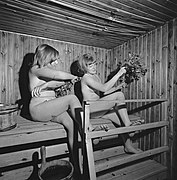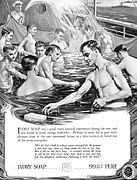Portal:Nudity: Difference between revisions
No edit summary |
m Reverted edit by 100.2.69.63 (talk) to last version by Grayfell |
||
| (14 intermediate revisions by 8 users not shown) | |||
Line 2:
<!-- This portal was created using {{subst:Basic portal start page}} -->
{{Portal description}}
{{Portal maintenance status |date=
{{Portals browsebar}}
__NOTOC__ __NOEDITSECTION__
Line 17:
|1=<!-- LEFT COLUMN -->
{{Box-header colour|Selected general article}}
{{ Transclude random excerpt
| paragraphs=1,2,3
| files=1
| fileargs=left
| more=
| History of nudity
| Naturism
| Body painting
| Depictions of nudity
| Freikörperkultur
| Nude (art)
| Nude beach
| Nudity and sexuality
| Nudity in film
| Stripper
| Toplessness}}
{{Box-footer}}
<!--CONDITIONAL DID YOU KNOW? SECTION - ONLY SHOWS UP WHEN THERE ARE ENTRIES TO DISPLAY-->
{{Transclude selected recent additions
| [Nn] | [Nn] | [Nn] | [Nn]udity | [Ss]triptease | months=36 | max=8 | header={{Box-header colour|Did you know... }} | footer={{Box-footer}} }}
<!--END OF DID YOU KNOW? SECTION-->
{{Box-header colour | Need help?}}
Do you have a question about Nudity that you can't find the answer to?
Line 27 ⟶ 55:
Consider asking it at the [[Wikipedia:Reference desk|Wikipedia reference desk]].
{{Box-footer}}
{{#ifexist: Wikipedia:WikiProject Nudity
For editor resources and to collaborate with other editors on improving Wikipedia's Nudity-related articles, see [[Wikipedia:WikiProject Nudity|WikiProject Nudity]].
{{Box-footer}}
|
}} <!-- END OF ifexist -->
|2=<!-- SECOND COLUMN -->
{{Box-header colour|
<div style="text-align: center;"><small>'''The following are images from various nudity-related articles on Wikipedia.'''</small></div>
{{Transclude files as random slideshow
| Nudity
Line 42 ⟶ 73:
}}
{{Box-footer}}
<!--CONDITIONAL NEWS SECTION - ONLY SHOWS UP WHEN THERE IS NEWS TO DISPLAY -->
{{Transclude selected current events
| [Nn]aked
| [Nn]aturis[mt]
| [Nn]ude
| [Nn]udis[mt]
| [Nn]udity
| [Ss]triptease
| days=45
| max=6
| header={{Box-header colour|In the news }}
| footer={{Box-footer}} }}
<!--END OF NEWS SECTION-->
{{Box-header colour|Subcategories}}
[[Image:C Puzzle.png|36px|right|Category puzzle]]
Line 51 ⟶ 94:
{{#tag:categorytree|Nudity}}
{{div col end}}
{{Box-footer}}
{{Box-header colour|''Related portals''}}
{{Related portals|Erotica and pornography|Politics|Human sexuality|Clothing}}
{{Box-footer}}
}} <!-- END OF FLEX COLUMNS -->
Line 64 ⟶ 110:
</div>
{{Portal navbar no header2}}
{{purge page}}
</div>
[[Category:Sexuality portals]]
[[Category:WikiProject Nudity]]
[[Category:Nudity| ]]
| |||
Latest revision as of 20:07, 20 June 2024

Nudity is the state of being in which a human is without clothing. While estimates vary, for the first 90,000 years of pre-history, anatomically modern humans were naked, having lost their body hair and living in hospitable climates. As humans became behaviorally modern, body adornments such as jewelry, tattoos, body paint and scarification became part of non-verbal communications, indicating a person's social and individual characteristics. Indigenous peoples in warm climates used clothing for decorative, symbolic or ceremonial purposes but were often nude, having neither the need to protect the body from the elements nor any conception of nakedness being shameful. In many societies, both ancient and contemporary, children might be naked until the beginning of puberty. Women may not cover their breasts, being associated with nursing babies more than with sexuality.
In the ancient civilizations of the Mediterranean, from Mesopotamia to the Roman Empire, proper attire was required to maintain social standing. The lower classes might possess a single piece of cloth that was wrapped or tied to cover the lower body; the lowest classes including slaves might be naked. However, through much of Western history until the late modern period, people of any status were also unclothed by necessity or convenience when engaged in labor and athletics; or when bathing or swimming. Such functional nudity occurred in groups that were usually but not always segregated by sex. Although improper dress might be socially embarrassing, the association of nudity with sin regarding sexuality began with Judeo-Christian societies, spreading through Europe in the post-classical period. Traditional clothing in temperate regions worldwide also reflect concerns for maintaining social status and order, as well as by necessity due to the colder climate. However, societies such as Japan and Finland maintain traditions of communal nudity based upon the use of baths and saunas that provided alternatives to sexualization.
The spread of Western concepts of modest dress was part of colonialism, and continues today with globalization. Contemporary social norms regarding nudity reflect cultural ambiguity towards the body and sexuality, and differing conceptions of what constitutes public versus private spaces. Norms relating to nudity are different for men than they are for women. Individuals may intentionally violate norms relating to nudity; those without power may use nudity as a form of protest, and those with power may impose nakedness on others as a form of punishment. (Full article...)

Toplessness refers to the state in which a woman's breasts, including her areolas and nipples, are exposed, especially in a public place or in a visual medium. The male equivalent is known as barechestedness.
Social norms around toplessness vary by context and location. Many indigenous societies consider breast exposure to be normal and uncontroversial. At specific beaches and resort destinations, notably in Europe and Australia, girls and women may sunbathe topless either by statute or by custom. However, in most countries, norms of female modesty require girls and women to cover their breasts in public, and many jurisdictions prosecute public toplessness as indecent exposure. The topfreedom movement opposes such laws on the grounds of gender equality.
Art and visual media throughout history, from painting and sculpture to film and photography, have frequently featured toplessness. Such representations are often defended on the grounds of artistic merit; toplessness may also be defended on educational, medical, or political grounds. Toplessness also features prominently in erotica, pornography, and at adult venues ranging from strip clubs to upmarket cabarets (such as the Moulin Rouge). (Full article...)
- ... that Susanna Hoffs sang on the studio recording of "Eternal Flame" naked after producer Davitt Sigerson pranked her by saying that Olivia Newton-John had done the same thing?
- ... that sales from Dieux du Stade, a nude calendar produced by the French professional rugby union club Stade Français featuring photos of its players, helped to finance the club for many years?
- ... that Meghan Trainor was inspired to write "Made You Look" after her therapist asked her to look at herself naked for five minutes?
- ... that the destroyed plinth of Gürdal Duyar's nude sculpture Güzel İstanbul contained reliefs of a fig, a pomegranate, a honeysuckle and a bee to represent different aspects of Istanbul?
- ... that Joachim Werzlau composed the music for the DEFA films Naked Among Wolves and Jacob the Liar?
- ... that film critic and censor D. I. Suchianu wanted Romanian moviegoers to cease "falling asleep whenever they're not shown a naked breast [or] a hip that's getting some action"?
- ... that Ettore Sottsass's design of the Olivetti Valentine typewriter was inspired by the pop-art nudes of Tom Wesselmann?
- ... that two nude bathers in Arnold Comes of Age were "nearly obliterated"?
Do you have a question about Nudity that you can't find the answer to?
Consider asking it at the Wikipedia reference desk.
For editor resources and to collaborate with other editors on improving Wikipedia's Nudity-related articles, see WikiProject Nudity.
The following Wikimedia Foundation sister projects provide more on this subject:
-
Commons
Free media repository -
Wikibooks
Free textbooks and manuals -
Wikidata
Free knowledge base -
Wikinews
Free-content news -
Wikiquote
Collection of quotations -
Wikisource
Free-content library -
Wikiversity
Free learning tools -
Wiktionary
Dictionary and thesaurus





































































